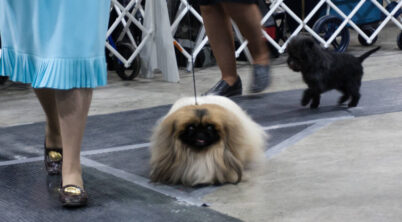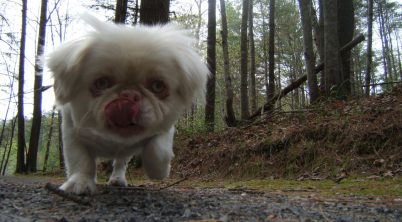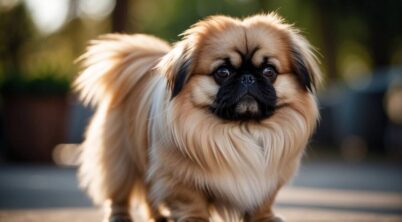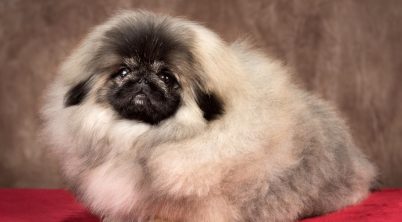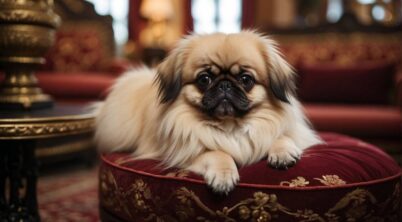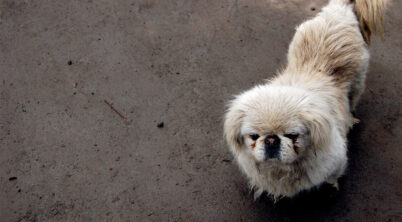The Pekingese breed has its roots deep in the annals of ancient Chinese history, originally bred to be companions to Chinese royalty. This legacy has bestowed upon the breed a rather distinctive demeanor – one that is regal and self-assured. Characterized by their affectionate nature, Pekingese dogs tend to form strong bonds with their owners, a trait that harks back to their days of close companionship with emperors and nobles. The breed’s loyalty and affectionate traits make them suitable companions in households, often resulting in them being closely knit with their human families.
In interactions with other dogs, the Pekingese can show varying degrees of compatibility. Often, their sociable attitude towards humans extends to other pets within the home, including other dogs. However, it’s noteworthy that this acceptance might not be indiscriminate, as the Pekingese may display selectivity in their canine friendships. The breed’s historical background as the cherished pet of the elite did not necessarily require them to be social butterflies with other dogs, which could influence their modern-day interactions. This behavior can be managed with proper socialization from a young age, helping the Pekingese to become more accepting and playful with other dogs.
With careful introduction and positive reinforcement, Pekingese can adapt to cohabitating with other dogs. Their peaceful and kind nature, often highlighted by their historical association with Chinese royalty, can make them good companions for other calm dog breeds. Despite their diminutive size, a legacy that possibly began to solidify when the breed was presented to Queen Victoria by British troops in 1860, they carry themselves with a dignified presence, in both human and canine company. Therefore, while Pekingese might exhibit some level of discernment in their canine interactions, they are capable of being friendly and harmonious residents in a multi-dog household.
Table of Contents
Social Interactions
The Pekingese breed exhibits a distinct personality that affects its interactions with dogs, pets, and children. Recognizing the traits of intelligence, loyalty, and confidence in the Pekingese can guide owners in fostering positive social experiences.
Do Pekingese Get Along with Other Dogs?
Pekingese may exhibit variable levels of friendliness toward other dogs. While some are sociable and enjoy canine companionship, others can demonstrate possessiveness or even aggression. These reactions are often attributed to the breed’s confident and somewhat stubborn nature. To encourage harmonious relationships, early and continuous socialization is crucial.
- Puppyhood Introduction: Introducing Pekingese to a variety of dogs during their puppyhood can help diminish defensive behaviors.
- Meet and Greet Protocol: Controlled environments and positive reinforcement play key roles in guiding a Pekingese to be more accepting of its peers.
Compatibility with Children and Pets
The Pekingese breed can be affectionate and playful, making them suitable companions for children who understand how to interact with dogs respectfully. Their intelligent and energetic disposition demands gentle handling to prevent defensive reactions.
- Cats and Other Pets: Interactions with cats and other household animals require supervision, as the Pekingese dog’s instinct may drive it to chase smaller, more active pets.
- Children: With proper introductions and oversight, Pekingese can develop bonds of companionship and loyalty with younger family members.
Training and Socialization
Despite their small size, Pekingese dogs possess a strong-willed temperament, making consistent training a necessity. Starting socialization and training early harnesses their smart and observant qualities.
- Positive Reinforcement: This method bolsters the Pekingese’s trainability, encouraging them to show friendly behavior toward both humans and animals.
- Class Attendance: Enrolling in puppy classes or socialization groups can mitigate the development of aggressive tendencies and promote a well-adjusted temperament.
Breed Characteristics
The Pekingese is a toy breed with a bold and sophisticated presence, often associated with a regal and dignified demeanor, reflecting its ancient heritage as a favored lap dog of Chinese royalty. They typically possess a compact, lion-like appearance, with their abundant mane being one of their most distinctive features.
Size and Weight
- Height: 6-9 inches
- Weight: 6-14 pounds
The breed’s brachycephalic (flat-faced) nature is marked by a short snout and facial wrinkles, which contribute to its unique expression. Pekingese are alert and intelligent, exhibiting an affectionate loyalty to their owners. However, their independent and somewhat opinionated nature can sometimes translate to stubbornness, requiring a patient and understanding approach to training.
Temperament
- Alert
- Intelligent
- Loyal
- Affectionate
- Independent
- Stubborn
- Gentle
- Dignified
- Opinionated
- Good-natured
Coat Colors
The Pekingese boasts a double coat that comes in various colors:
- Red
- Sable
- White
- Cream
- Black
- Black and Tan
- Gray
- Red Sable
- Fawn Sable
This breed’s sophisticated appearance and gentle temperament make it a cherished companion, though it may display a level of independence when interacting with other dogs or animals. Owners should be mindful of the Pekingese’s good-natured yet self-assured character, which can influence their social behavior.
Choosing a Pekingese

When considering adding a Pekingese to the household, it’s important to understand their heritage and characteristics. Known as “lion dogs” due to their resemblance to Chinese guardian lions, these dogs have a regal history, originating from ancient China as companions to Chinese royalty. The Pekingese Club of America and the American Kennel Club (AKC) offer resources on breed standards and care, emphasizing the importance of finding a reputable breeder.
Breed Overview:
- Lifespan: Typically 13 to 15 years.
- Size: Classified as a toy breed.
- Role: Historically served as lapdogs and sleeve dogs, a reference to their role sitting in the ample sleeves of Chinese nobility.
Pekingese possess a watchful nature, making them good watchdogs, yet they are not typically considered guard dogs due to their small size. They have moderate energy levels and a bold intelligence that reflects their noble lineage.
When interacting with other dogs, Pekingese may exhibit a range of behaviors. They are not bred specifically for compatibility with other breeds like the Shih Tzu or Pug, but with proper socialization, they can become good family pets and companions.
Relevant Considerations:
- Temperament: They can be independent and possessive, traits that require thoughtful socialization, especially if they are to be around other pets.
- Health: Ensuring they are from a reputable source helps in anticipating any hereditary health issues.
- Grooming: Their luxurious coats require regular maintenance.
The affectionate nature of the Pekingese, when well-socialized, complements its distinct personality, making this breed a unique companion that embodies its ancient, royal roots.



